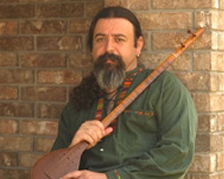Kourosh Taghavi
Persian setar
 The setar (four-stringed lute) is one of the oldest Persian instruments for which the Persian classical repertoire was orginally designed. Persian music is an improvisatory music based on a systematic framework called the Radif. The Radif, the foundaiton for Persian classical music, contains seven complex systems call Dastgah and five less elaborated systems called Avaz. Each of these systems are maed out of short by complex melodies that are called Gusheh. The traditional method of teaching the Radif is one-on-one by a master teacher to a student. The Radif must be memorized exactly as they have been passed on through history, and in turn a performer can then create their own material of improvisations and/or compositions.
The setar (four-stringed lute) is one of the oldest Persian instruments for which the Persian classical repertoire was orginally designed. Persian music is an improvisatory music based on a systematic framework called the Radif. The Radif, the foundaiton for Persian classical music, contains seven complex systems call Dastgah and five less elaborated systems called Avaz. Each of these systems are maed out of short by complex melodies that are called Gusheh. The traditional method of teaching the Radif is one-on-one by a master teacher to a student. The Radif must be memorized exactly as they have been passed on through history, and in turn a performer can then create their own material of improvisations and/or compositions.
Kourosh Taghavi has played the setar for over 20 years. As an exception to the rule, Kourosh began his musical training later in life after having arrived in the United States as a teen, making the choice to become a musician when he was 24. Kourosh attributes much of his learning to two master artists: pioneer classical musician, Ostad Mohammad Reza Lotfi (linked to the lineage of Ostad Ali Akbar Shahnâzi) and, later in Taghavi’s career, composer and musician Ostad Hossein Alizadeh. These two remain key influences, considered by Kourosh as “two of the greatest masters of Persian classical music” who have deeply impacted his approach and journey as a teacher and musician.
Kourosh was a master artist in ACTA’s Apprenticeship Program in 2008, with apprentice Emad Borjian. Their apprenticeship focused on the Dastgah Shur, including traditional compositions and improvisational approaches related to it.



